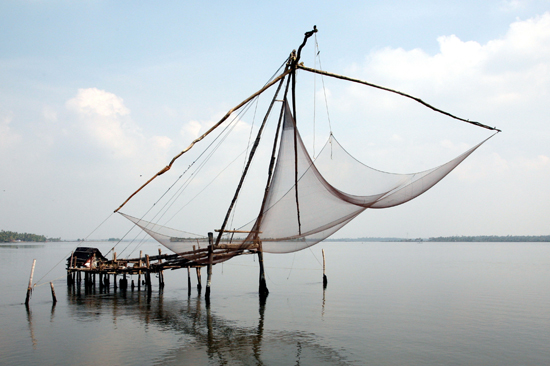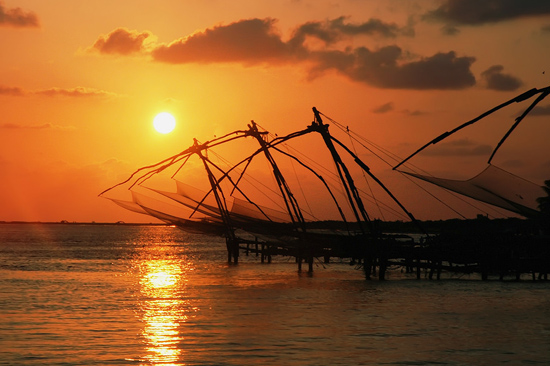Chinese fishing nets are fixed land installations for fishing. The more formal name for such nets is "shore operated lift nets". It was earlier thought that the nets might have been introduced by the Chinese explorer Zheng He. Recent research shows that these were introduced by Portuguese Casado settlers from Macau.
Normally using night time for fishing. Each installation is operated by a team of up to six fishermen. A Light/ lamb has been fixed in the top of the net. After Putting the net into the water The Light attracts fishes to the net and the net lift up with the catched fishes.
These nets are constructed out of Teak wood or metal pipes, they work on the principle of balance.
The system is sufficiently balanced that the weight of a man walking along the main beam is sufficient to cause the net to descend into the water. The net is left for a short time before it is raised by pulling on ropes.
The system of counterweights is most ingenious. Rocks, each 30 cm or so in diameter are suspended from ropes of different lengths. As the net is raised, some of the rocks one-by-one come to rest on a platform thereby keeping everything in balance.
The Chinese fishing nets have become a very popular tourist attraction, their size and elegant construction is photogenic and the slow rhythm of their operation is quite hypnotic. You can see Chinese fishing nets between Kollam and Thrikkunnappuzha mainly in Ashtamudi Lake and Kayamkulam Lake


Normally using night time for fishing. Each installation is operated by a team of up to six fishermen. A Light/ lamb has been fixed in the top of the net. After Putting the net into the water The Light attracts fishes to the net and the net lift up with the catched fishes.
These nets are constructed out of Teak wood or metal pipes, they work on the principle of balance.
The system is sufficiently balanced that the weight of a man walking along the main beam is sufficient to cause the net to descend into the water. The net is left for a short time before it is raised by pulling on ropes.
The system of counterweights is most ingenious. Rocks, each 30 cm or so in diameter are suspended from ropes of different lengths. As the net is raised, some of the rocks one-by-one come to rest on a platform thereby keeping everything in balance.
The Chinese fishing nets have become a very popular tourist attraction, their size and elegant construction is photogenic and the slow rhythm of their operation is quite hypnotic. You can see Chinese fishing nets between Kollam and Thrikkunnappuzha mainly in Ashtamudi Lake and Kayamkulam Lake



